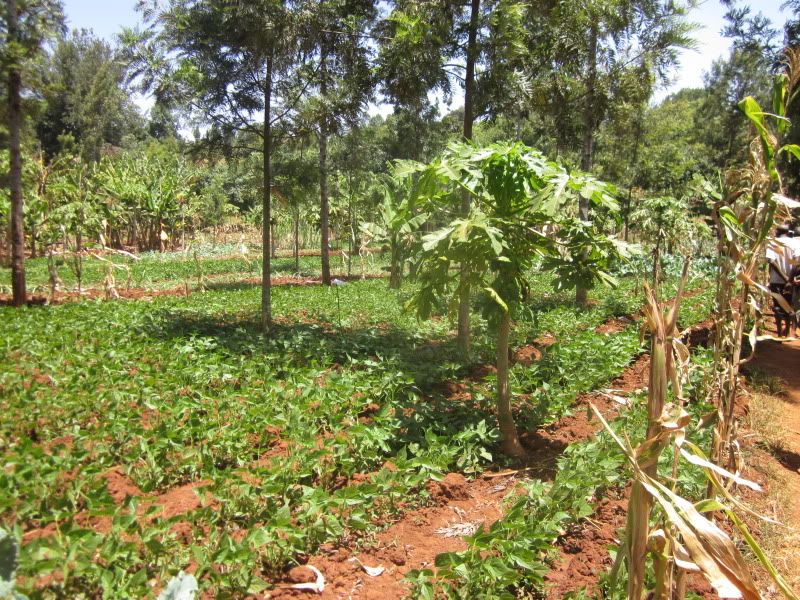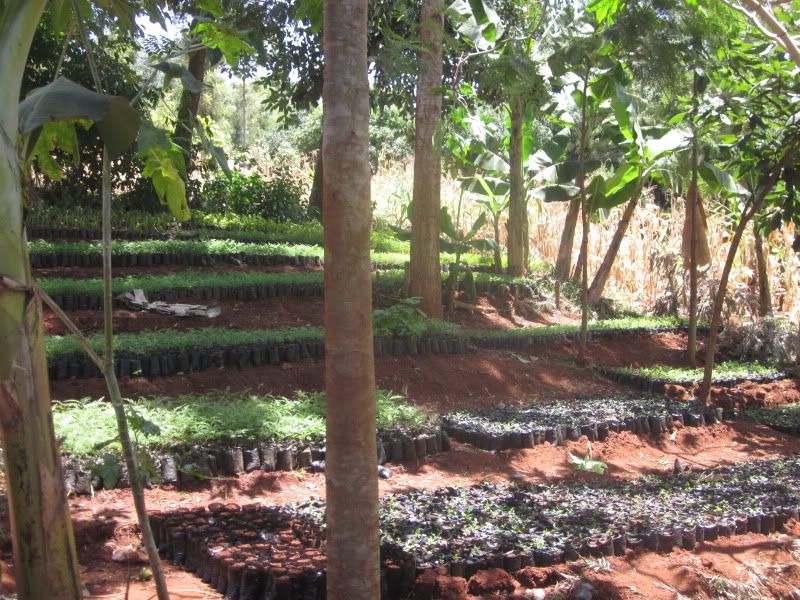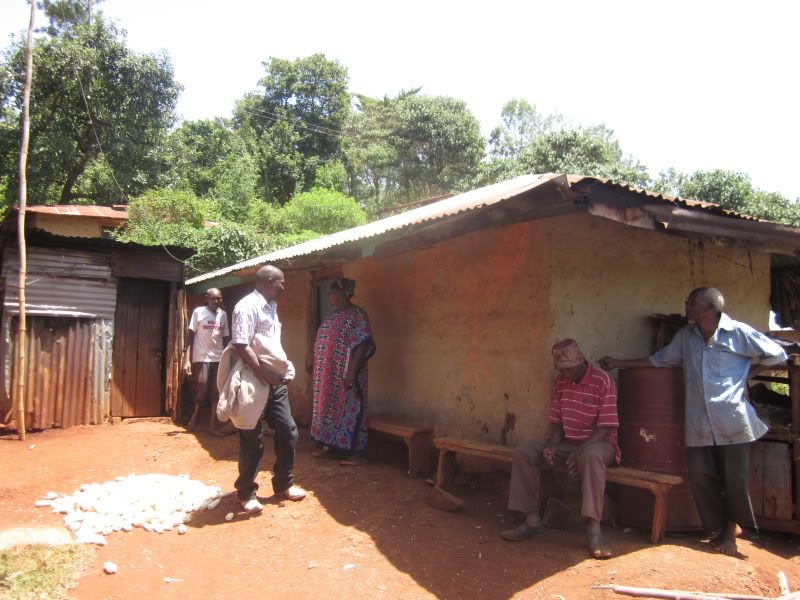
Best. Picture. Ever!!!! (Read his shirt)
Kenya is split between wet, semi-arid, and arid zones. The mountainous wet zones are used to grow some of the top cash crops - tea and coffee. Thika itself is in a semi-arid zone but it is not far from a wetter area. Francis had recently begun working in the wet area too so he could compare farming there with farming in the semi-arid region. To get there, we rode a matatu, Kenya's privately run mini-buses that seat 15 (including the driver) but regularly cram 20+ people in to earn as much money as possible. Unlike a public bus, matatus will stop and drop you off or pick you up anywhere along the route. This is nice because you can go exactly where you want, and not nice because you have to stop all the time so that everyone else can go exactly where they want.

A market near the junction where we went to catch our matatu
While in Kenya, I heard 2 funny sayings. One is that there's always room for one more person in a matatu. The second is 'matatu matata.' Matata is Swahili for 'trouble.' As in 'hakuna matata.' Both sayings are true. I'd add that if you can get the matatu door shut, then you definitely have room for at least 2 more people. And just when people start to leave the matatu and you get comfortable because you've got a seat all to yourself, that's when the driver will sit and wait so he can fill up the car before driving further.
The nicest thing I can say about the matatu is: it's cheap. A ride that costs $50 in a private car with a driver will cost less than $2 in a matatu. As we drove to the wet region, I was glad to have Francis with me to make sure we got charged a fair price and to make sure we got our change after we paid too. A mzungu like me riding alone is sure to get overcharged.
While we road, the scenery changed. Suddenly, the plants around us were green! We got off and then set off away from the road for a small village. Their entire community decided together to go organic, and every single farmer except for one has done so. To make the transition, they are working with SARDI (Sustainable Ag & Rural Development Initiative) and they are using the Grow Biointensive method of farming.

The view as we approached the village. The area across the river had terraces but I did not really observe terraces where we were.
We walked up to a house with a cow and then stopped. Several people met us and then we continued walking down the hill toward a river. I felt compelled to ask whether this river also contained hippos - or for that matter, crocs. No, neither. A little less exciting for me, but ultimately a very good thing for local farmers.
We started by a small plant nursery, where I was introduced to the farmers, Waithera Kimotho and her husband Francis Kimotho. Waithera's the farmer. They've been working with SARDI for five months. We were joined by their neighbor Simon Kiarie. They walked me through the farm from the nursery all the way down to the riverside, where the property ended. They told me this land was only 1/4 acre but it seemed bigger. No bigger than an acre though. It was not a large farm.

Nursery

Waithera and Francis Kimotho

The couple was married in the 1980s and they have seven children. The oldest child is 32 years old. They use the river water for irrigation. They used to carry the water in buckets but with the extra money they made since going organic, they bought a water pump. To grow their crops, they often plant seeds in a seed bed and then transplant the seedlings.
Before working with SARDI, Waithera used chemicals. I asked if she's had any problems with using organic methods. She said she has not experienced any problems - she's getting robust yields. She said she grows 'pole pole' in a good way. "Pole pole" is Swahili for little by little. In the past, sometimes when she would use chemicals, she would have stomach problems after eating the crops. Back then, the pests would eat the crops even though she used chemicals to kill them. Now, she no longer has pest problems.
Waithera found SARDI at a nearby training session and she approached them to work with them. Her farm is entirely run on family labor - no hired help. She says that organic farming is actually easier - less labor - than farming with chemicals.

Kale a.k.a. sukumawiki

Kale
As you look at photos of the farm, you'll see that the soil here is red. They call it Kikuyu Red Soil. The people here are from the Kikuyu ethnic group, the largest ethnic group in Kenya. At this farm, Waithera grows cabbage, kale, papaya, avocado, banana, passionfruit, spinach, French beans, cowpeas, Gravillea, cassava, maize, beans, and flowers. They eat the food they grow, and they sell the crops to earn an income as well.

Notice the spacing. They have beds that are a few feet wide with aisles in between.

These beds are not weed-free. But nor are the weeds overtaking the plants and preventing the farmer from getting a good crop.

Maize used as windbreaks, trees intercropped with plants. The tall trees are gravillea (a popular tree crop here, which I assume is used as lumber and/or fuel) and the one in the front is papaya. Looks like the crop might be green beans.

Banana trees



No doubt you've noticed that the various beds are in different stages of growth. Some are just planted, others are more mature plants. Grow Biointensive, which was developed in northern California where there is year-round good weather and irrigation water too, teaches farmers to do this so they always have something to harvest. I wonder how good that idea is though for rainfed agriculture in a place like Kenya that traditionally has two rainy seasons each year and in many places the rest of the year is quite dry. Fortunately this particular area is blessed with more rainfall and with a river to provide irrigation water - although a farmer wishing to irrigate has to carry the water from the river by hand unless he or she has an electric pump.
Most Kenyan farmers who lack irrigation plant twice a year, once during the 'short rains' in November and once during the 'long rains' in March. However, the rainy seasons have become less dependable with the onset of the climate crisis. Assuming the rains don't fail and a farmer gets a crop, then they eat what they harvest each season and now - at the end of the dry season - their diets get rather monotonous, full of whatever stores well, like maize, beans, and cabbage. But on irrigated biointensive farms, everything is growing all the time. The exception are the few crops like maize and beans that store well. Those are still planted during the rains from what I observed.

Sugarcane, I think. Sugarcane is a popular treat in Kenya. It's sold by street vendors who peel it with a panga (machete) and cut it into chunks.

The compost pile

Flowers, being grown under a cover to protect them from the sun.

The flowers are being grown under here.

A better look at the plant nursery.


Tree tomatoes, I think
Tree tomato (Cyphomandra betacea) is a native Andean crop and I was shocked to find out that it's a popular fruit in Kenya. In Nairobi, you can get tree tomato juice in some restaurants.
We then trekked back up the hill to the house to see the cows. Waithera used to have a dairy cow but it was stolen. She now has two bulls - a mature one and a calf. She opted for bulls instead of a dairy cow because she didn't want her animals to be as tempting to thieves. She sells her bulls when she needs money. She can sell them at any point after they are 1 year old.

Cow
She chooses to get "grade" (specific breeds typically brought in from foreign countries because of their fast growth or high milk production) cows instead of the local breeds, and says she's kept grade cows for years. I asked which breed these were (Angus?) and someone with us suggested they might be Holstein. They absolutely are not Holstein (black and white spotted dairy cows). She said the difference between 'grade' cows and local breeds is that the grade cows will grow to full size in three years instead of four.

Waithera near the cow enclosure.
Waithera does what Kenyans call 'zero grazing.' That just means keeping your animal confined and bringing the food to it instead of letting it out on pasture. It's a relatively new concept in Kenya. Waithera doesn't have enough land to let her cows out to graze much, so if she's going to have a cow, this is the only real option for her. Also, although Waithera didn't say, grade animals often must be kept confined for other reasons: they are very susceptible to local diseases (unlike the local breeds) and they need more food and water and wouldn't get enough calories if they went out grazing on local vegetation. I think the issue of getting enough calories is particularly true of dairy cows because producing milk takes a lot of calories. Grade animals are given 'supplements' - high calorie food that I think typically includes molasses.

Waithera and Francis Kimotho's home
We finished up at the Kimotho's home and then set off for Simon's farm.
No comments:
Post a Comment